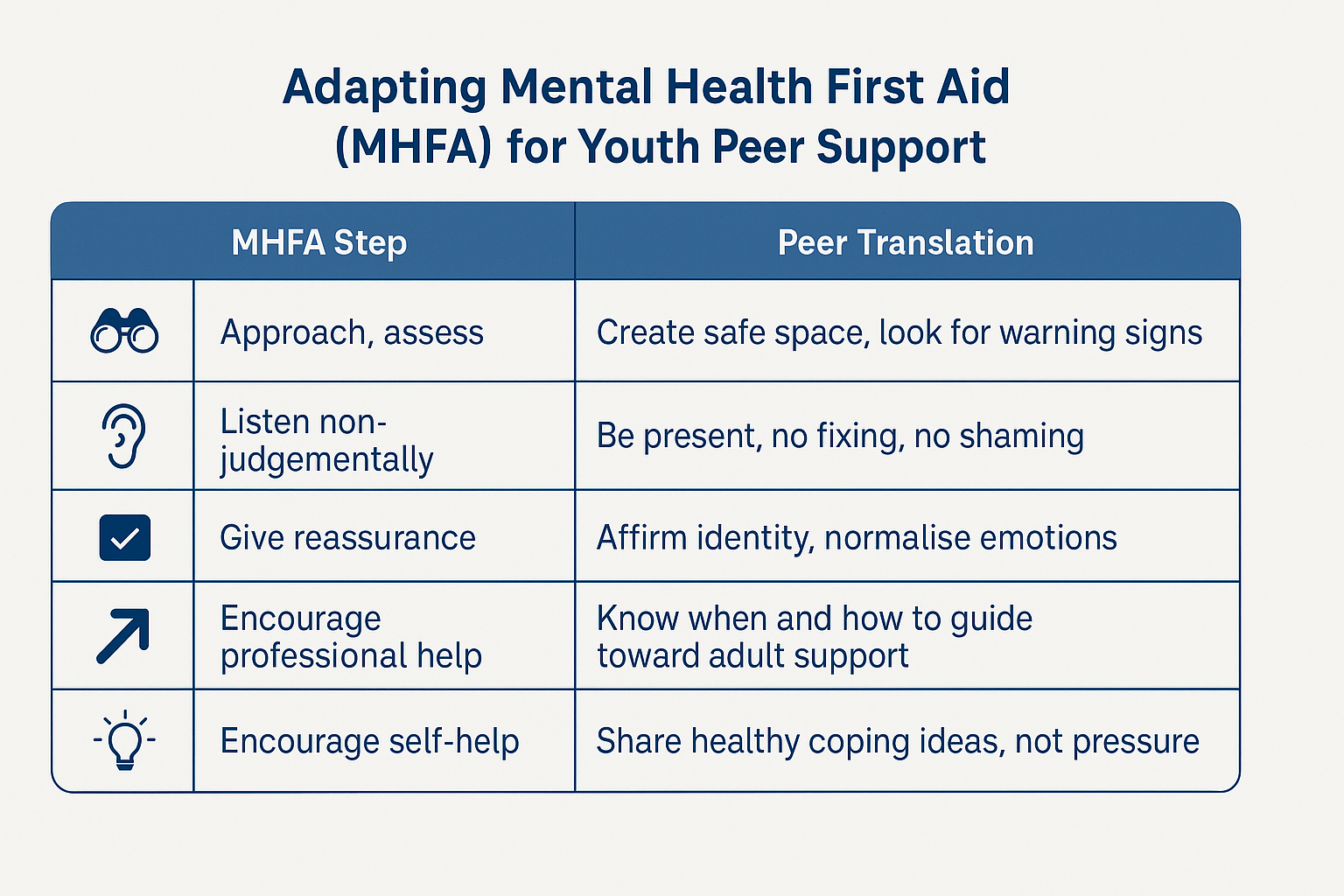How MHFA-Informed Peer Support Can Help LGBTQI+ Students Feel Safer In Schools
We know that LGBTQI+ young people often seek help from friends long before they approach a teacher or mental health professional. These moments matter. They can shape a young person’s sense of safety, trust, and identity.
But they can also be heavy to carry. Without training or boundaries, peers can be left feeling overwhelmed, isolated, or unsure of what to do.
An important note on language and framing
This article does not suggest that sexuality or gender identity are mental health conditions. Being LGBTQI+ is not a diagnosis: it is a valid, lived identity. However, the stigma, isolation, and discrimination that many LGBTQI+ young people face can have a significant impact on their well-being. That is where the principles of Mental Health First Aid (MHFA) become relevant, not to pathologise identity, but to equip peers and educators with tools to respond to distress with empathy, structure, and safety.
At Let’s Be Real, we’ve worked with schools, and students to co-create trauma-informed LGBTQI+ peer support programmes. This article draws on what we’ve learned, alongside emerging evidence and best practice. If your school is exploring similar work, we’d love to be in conversation.
Why LGBTQI+ Student Peer Support Matters in Schools
LGBTQI+ students face higher risks of mental ill-health, including depression, anxiety, and self-harm. These risks often stem not from identity itself, but from experiences of discrimination, exclusion, and fear of being misunderstood. The research confirms this. Students with supportive peer networks and affirming school environments report significantly better mental health outcomes and reduced suicidality (The Trevor Project, 2022).
Yet LGBTQI+ students often hesitate to seek formal help. That’s why structured, safe peer support programmes in schools are an essential bridge. especially when those programmes reflect young people’s lived experiences and identities.
“I was the first person they told. I didn’t know what to say; just that I had to be there.”
— Jana, 16, peer mentor
Common Risks When Peer Support Isn’t Structured
Even the kindest intentions can lead to harm if schools set up peer support without clear boundaries or training. Some risks include:
Emotional burnout: Young people take on too much emotional weight
Misinformation: Untrained peers give advice that’s not safe or evidence-based
Boundary confusion: No clear lines around confidentiality or role limits
Lack of escalation: Serious concerns aren’t passed on to trusted adults
A systematic review of youth peer-led interventions found that while benefits exist, peer supporters themselves may experience emotional burden or guilt without proper supervision (King & Fazel, 2021).
Adapting Mental Health First Aid (MHFA) for Youth Peer Support
MHFA principles, especially the ALGEE framework, can be adapted for use in student peer programmes. While MHFA is often taught to adults, its core ideas translate really well for school-based peer support.
💡 Teach peer mentors to see themselves as connectors, not fixers. That framing reduces pressure, and prevents harm.
How to Create a Sustainable Peer Support Programme for LGBTQI+ Students
1. Recruit With Intention
Invite applications from across identities, especially those often underrepresented in school leadership roles
Prioritise empathy, reliability, and boundaries over popularity
2. Train for Real-World Conversations
Focus on active listening, risk recognition, and safe referrals
Include role-plays relevant to LGBTQI+ experiences (e.g., family rejection, pronoun changes, internalised shame)
3. Establish Clear Scope and Safeguarding
Define what peer mentors can do: listen, validate, guide
Clarify what they can’t do: keep secrets around harm, diagnose, provide therapy
4. Supervision and Debriefing Are Essential
Assign a trusted adult to support the programme
Build in reflective check-ins to prevent peer burnout
5. Make It Visible, Without Pressure
Use opt-in visibility tools (badges, posters, quiet signposting)
Never place emotional labour on marginalised students without consent
See the Anna Freud Centre’s school wellbeing resources for more implementation ideas.
What Peer Support Can Look Like: A Composite Story
Kai, 17, was trained as part of their school’s LGBTQI+ Peer Listening Network. When a younger student confided in them about anxiety linked to bullying, Kai didn’t rush to fix it. They said:
“Thanks for telling me. That sounds really hard. I can sit with you while we talk to our staff lead, if you’d like.”
The student accessed help. Kai felt supported. No one carried it alone.
What a Healthy Peer Support Culture Feels Like
Peer supporters know their role and its limits
Supervision is consistent, and not just reactive
LGBTQI+ students report feeling safer and better supported
Adults are involved, not to control, but to care
When this culture exists, peer support becomes part of your wider school wellbeing strategy, not an isolated initiative.
Final Thought
When LGBTQI+ students support one another with care, structure, and solidarity, they aren’t just sharing stories; they’re shaping a culture. A culture where being seen isn’t risky, but restorative.
“Empathy without support burns out. Empathy with structure builds belonging.”
About LetsBe Real
Lets Be Real is an organisation supporting youth-led, trauma-informed mental health practices, rooted in inclusion, equity, and real connection. We co-design with schools, educators, and communities across Europe.
📬 hello@letsbe-real.eu
🌍 letsbe-real.eu
References
Hart, L. M. et al. (2018). Helping adolescents to better support their peers with a mental health problem: A cluster-randomised crossover trial of teen Mental Health First Aid. Aust N Z J Psychiatry, 52(7), 638–651. https://doi.org/10.1177/0004867417753552
King, T., & Fazel, M. (2021). Examining the mental health outcomes of school-based peer-led interventions on young people. PLOS ONE, 16(4), e0249553. https://doi.org/10.1371/journal.pone.0249553
The Trevor Project. (2022). National Survey on LGBTQ Youth Mental Health. https://www.thetrevorproject.org/survey-2022/
Anna Freud Centre. (n.d.). Establish a peer support programme in your school or college. https://www.annafreud.org/resources/schools-and-colleges/5-steps/promoting-wellbeing/


